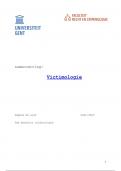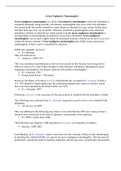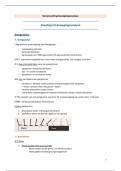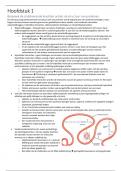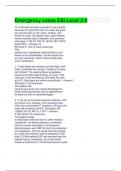Agonist/receptor theories
Categorising drug action in terms of receptors is a central theme of pharmacology; the study of the
interactions between drugs and receptors at a molecular or biochemical level is known as
pharmacodynamics
1905 - Langley introduced the idea of ‘receptive substance’ – the part of a cell with which hormones
and transmitters interact
Lock and key hypothesis
1926 – Clark proposed that there is a reversible monomolecular reaction between acetylcholine and
its receptive substance; the receptive substance (receptor) only accounts for a small part of the cell
Receptor occupancy is related to drug concentration; response is related to drug concentration;
response is related to receptor occupancy; agonist + receptor = agonist-receptor complex/response
A + R -> AR
At equilibrium: from basic kinetic theory; agonist-receptor complex
concentration is proportional to [A] and [R]
The rate at which the AR complexes dissociate is proportional to the concentration of AR; in 3, the
constant is the dissociation constant, KA
KA = dissociation (equilibrium) constant for agonist A; Kaff = affinity constant for agonist A
Referring to the equation KA= [A][R]/ [AR]; high affinity=low KA and low affinity= high KA
Determining relationship of receptor occupancy (y) to [A], KA at equilibrium
If y = proportion of receptors occupied (where 1
= all possible receptors bound i.e., maximum
binding), binding as fraction of maximum binding
When y = 0.5 then KA = [A]
In a drug binding curve
When we express the concentration of agonist against occupancy, i.e., the
fraction of receptors that are bound (y), at y = 0.5, we can determine the KA
Relate the binding (occupancy/y) to the
response (EA/EM); response = binding
,y = proportion of receptors occupied by A
KA = dissociation constant for agonist A
[A] = concentration of A
Partial agonists
Drugs that bind receptors but inefficiently, therefore incapable of
giving maximal response (thus acts as an antagonist)
Ariens theory – response = α y; α = intrinsic activity; therefore,
response is equal to the intrinsic activity of a drug multiplied by y
At half maximal occupancy, a partial agonist yields a smaller response
because it has a smaller intrinsic activity
Model for efficacy
Many full agonists could elicit maximal responses at very low
occupancies – concept of receptor reserve; response does not
relate directly to receptor occupancy (can be expressed in
terms of efficacy – describes the strength of a single drug
receptor complex in evoking a response)
, Competitive antagonism
Agonist potency, pD2
Expressed like the pH system
Agonist + agonist synergy
Convergent signalling – different receptors; effect is
more than adding effects of 1 and 2
Additive effect
Common receptor
Full agonist + partial agonist – partial antagonism
Partial agonist A2 cannot reach maximal effect
Competitive antagonism
A + R -> AR – response; B + R -> BR – no response
Competitive antagonists can be quantitively understood by the amount of extra agonist we need to in
the presence of the antagonist, to restore the response (normally 50% of the maximal response);
calculate the dose ratio
, How to plot the slope of a graph where the intercept = 0
Straight line indicates parallelism – increasing
concentrations of B causes parallel shifts to the
right of the dose response
In log terms –
<- graph where y=mx
In a graph where the y intercept is not 0 –> y = mx + b
Antagonist occupancy (z)
Agonist occupancy = y
When DR = 10 then z = 0.9
Therefore when 1/10 of receptors are free, require 10x more A
Categorising drug action in terms of receptors is a central theme of pharmacology; the study of the
interactions between drugs and receptors at a molecular or biochemical level is known as
pharmacodynamics
1905 - Langley introduced the idea of ‘receptive substance’ – the part of a cell with which hormones
and transmitters interact
Lock and key hypothesis
1926 – Clark proposed that there is a reversible monomolecular reaction between acetylcholine and
its receptive substance; the receptive substance (receptor) only accounts for a small part of the cell
Receptor occupancy is related to drug concentration; response is related to drug concentration;
response is related to receptor occupancy; agonist + receptor = agonist-receptor complex/response
A + R -> AR
At equilibrium: from basic kinetic theory; agonist-receptor complex
concentration is proportional to [A] and [R]
The rate at which the AR complexes dissociate is proportional to the concentration of AR; in 3, the
constant is the dissociation constant, KA
KA = dissociation (equilibrium) constant for agonist A; Kaff = affinity constant for agonist A
Referring to the equation KA= [A][R]/ [AR]; high affinity=low KA and low affinity= high KA
Determining relationship of receptor occupancy (y) to [A], KA at equilibrium
If y = proportion of receptors occupied (where 1
= all possible receptors bound i.e., maximum
binding), binding as fraction of maximum binding
When y = 0.5 then KA = [A]
In a drug binding curve
When we express the concentration of agonist against occupancy, i.e., the
fraction of receptors that are bound (y), at y = 0.5, we can determine the KA
Relate the binding (occupancy/y) to the
response (EA/EM); response = binding
,y = proportion of receptors occupied by A
KA = dissociation constant for agonist A
[A] = concentration of A
Partial agonists
Drugs that bind receptors but inefficiently, therefore incapable of
giving maximal response (thus acts as an antagonist)
Ariens theory – response = α y; α = intrinsic activity; therefore,
response is equal to the intrinsic activity of a drug multiplied by y
At half maximal occupancy, a partial agonist yields a smaller response
because it has a smaller intrinsic activity
Model for efficacy
Many full agonists could elicit maximal responses at very low
occupancies – concept of receptor reserve; response does not
relate directly to receptor occupancy (can be expressed in
terms of efficacy – describes the strength of a single drug
receptor complex in evoking a response)
, Competitive antagonism
Agonist potency, pD2
Expressed like the pH system
Agonist + agonist synergy
Convergent signalling – different receptors; effect is
more than adding effects of 1 and 2
Additive effect
Common receptor
Full agonist + partial agonist – partial antagonism
Partial agonist A2 cannot reach maximal effect
Competitive antagonism
A + R -> AR – response; B + R -> BR – no response
Competitive antagonists can be quantitively understood by the amount of extra agonist we need to in
the presence of the antagonist, to restore the response (normally 50% of the maximal response);
calculate the dose ratio
, How to plot the slope of a graph where the intercept = 0
Straight line indicates parallelism – increasing
concentrations of B causes parallel shifts to the
right of the dose response
In log terms –
<- graph where y=mx
In a graph where the y intercept is not 0 –> y = mx + b
Antagonist occupancy (z)
Agonist occupancy = y
When DR = 10 then z = 0.9
Therefore when 1/10 of receptors are free, require 10x more A

